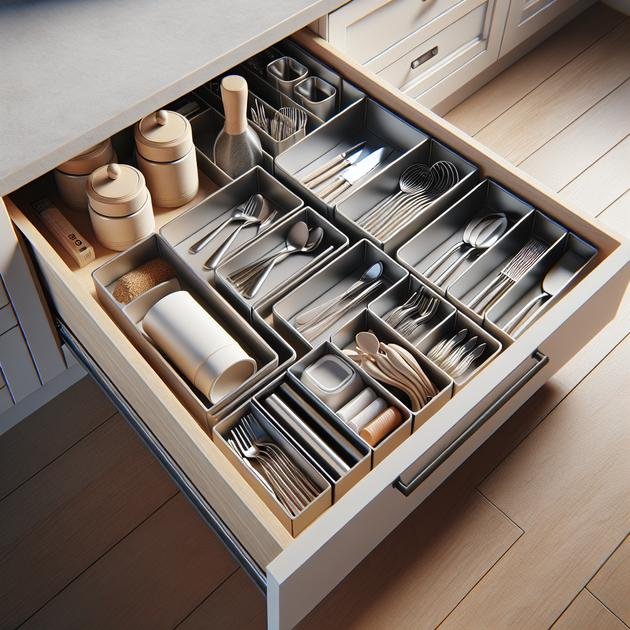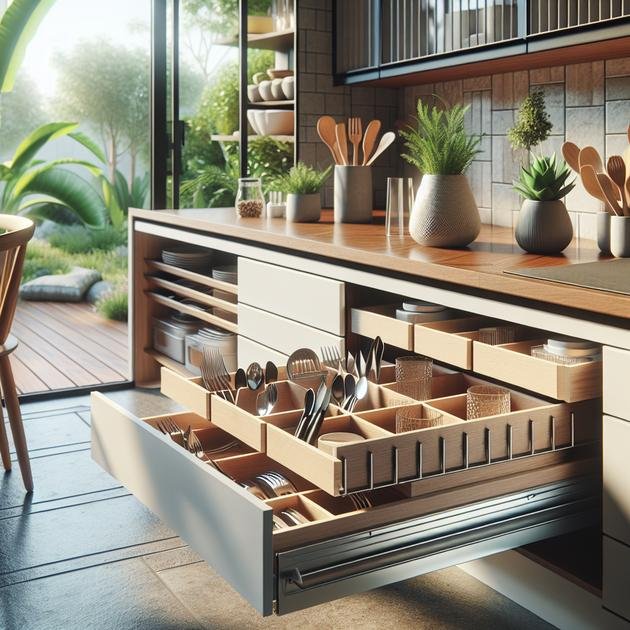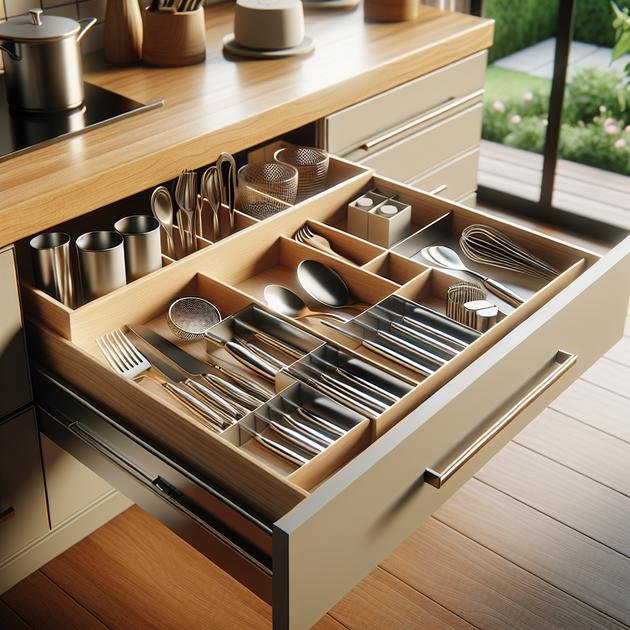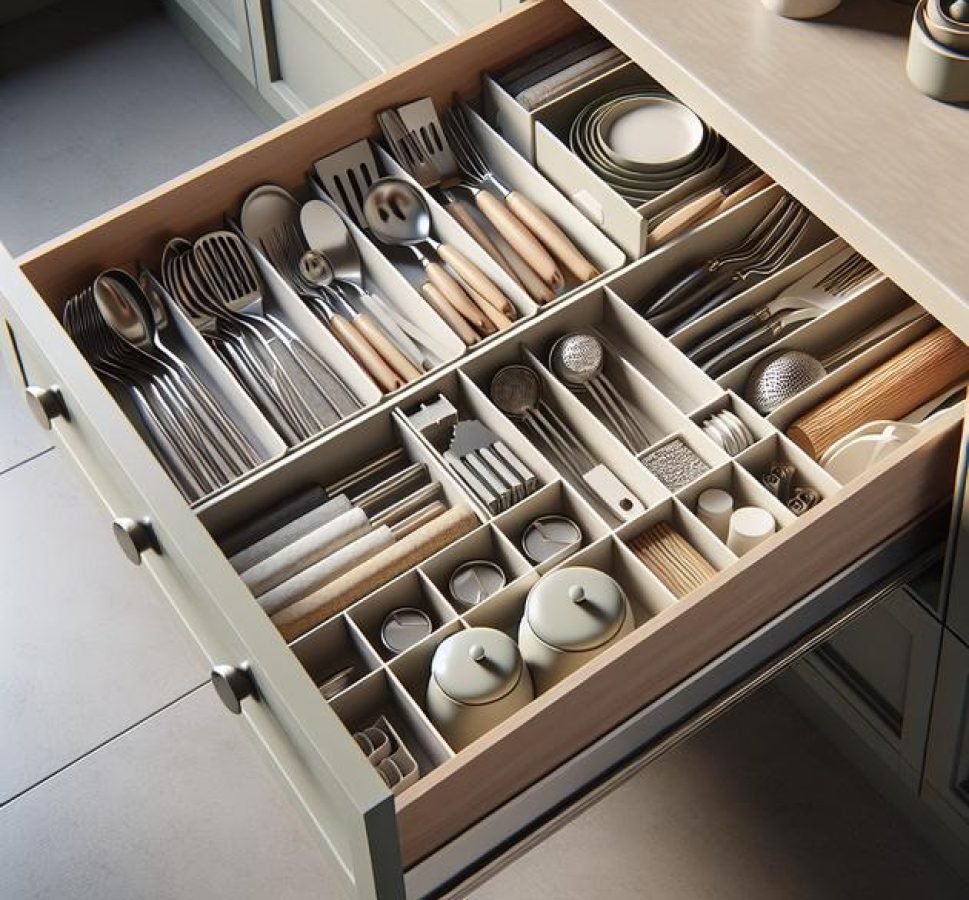Kitchen drawer organizers improve efficiency by keeping utensils and gadgets neatly separated, maximize space with adjustable dividers and tiered racks, and maintain order with labels and regular cleaning to create a functional, clutter-free kitchen environment.
Have you ever noticed how a messy drawer can slow down your kitchen routine? With kitchen drawer organizers, you can turn that chaos into harmony. Let’s explore ideas that might just change how you see your drawers.
why kitchen drawer organization makes a difference
Organizing your kitchen drawers can dramatically improve your daily cooking experience. When everything has a specific place, you save time searching for utensils, gadgets, or tools. This simple change can reduce stress and make meal prep smoother and more enjoyable.
Well-organized drawers also help maintain cleanliness and reduce clutter by ensuring that items don’t pile up uncontrolled. This allows for better use of available space, especially in smaller kitchens where every inch counts.
Efficiency and Convenience
With a clear system in place, you can grab what you need quickly, which means less time fumbling through messy drawers and more time cooking or enjoying your meal. Kitchen drawer organization means improved workflow and can encourage healthier cooking habits by making tools and ingredients more accessible.
Protecting Your Kitchenware
Properly organized drawers reduce wear and tear on your utensils and gadgets. When items aren’t jumbled together, they are less likely to get scratched or damaged, extending their lifespan and saving you money on replacements.
Boosting Aesthetics and Value
Neatly arranged kitchen drawers are visually appealing and can boost the overall look of your kitchen. For homeowners, this tidy impression adds value and could influence buyers if you ever decide to sell.
Ultimately, kitchen drawer organizers turn a simple drawer into a functional space that makes your kitchen work better for you, enhancing your lifestyle in small but meaningful ways.
types of kitchen drawer organizers you can find
When choosing kitchen drawer organizers, understanding the types available can help you pick what fits your needs best. There are several popular options designed to keep different items tidy and accessible.
Drawer Dividers
These are simple inserts that separate your drawer into sections. They work well for utensils, tools, and even cutting boards. Dividers can be adjustable or fixed, letting you customize space based on the drawer’s contents.
Bamboo or Wooden Trays
Natural materials like bamboo or wood trays not only organize but add a warm, stylish touch. These trays often come with compartments of varying sizes, perfect for silverware or kitchen gadgets.
Plastic or Acrylic Organizers
Clear plastic or acrylic organizers allow you to see what’s inside easily. They’re lightweight, easy to clean, and often come with multiple compartments. Some feature lids for added protection from dust.
Expandable Organizers
Expandable options adjust to different drawer widths, making them very versatile. They often feature segmented sections that can organize utensils, knives, or tools efficiently.
Specialized Organizers
Some organizers are designed specifically for spices, knives, or baking tools. These help you keep frequently used items in order and easy to find, enhancing your kitchen workflow.
Choosing the right type depends on your kitchen habits, drawer sizes, and the items you want to organize. Mixing different organizers can maximize drawer space and functionality.
how to measure your drawers for the perfect fit
Measuring your kitchen drawers correctly is essential to find the perfect kitchen drawer organizers that fit well and maximize space. Begin by clearing out the drawer completely to get accurate measurements without obstruction.
Steps to Measure Your Drawers
Use a tape measure to record the interior width, depth, and height of the drawer. Make sure to measure from wall to wall inside the drawer, not the outer edges, to get the usable space.
Width: Measure the left to right inside dimension.
Depth: Measure from the front to the back inner edge.
Height: Measure from the bottom of the drawer to the top edge inside.
Tips for Accurate Measuring
Measure twice to confirm accuracy. If your drawers have uneven sides, take the smallest measurement to ensure the organizer will fit properly. Also, consider any obstructions like drawer lips or built-in dividers.
Additional Considerations
Think about the height of items you plan to store. Some organizers are tall, so knowing the drawer height helps avoid getting organizers that won’t fit. If unsure, take photos or sketches to help visualize where organizers will go.
Following these measuring tips will help you select drawer organizers that fit perfectly, keeping your kitchen drawers neat and efficient.
best materials for durable organizers

Choosing the right materials for kitchen drawer organizers is key for durability and long-lasting use. Different materials offer unique benefits depending on your kitchen needs and style.
Wood and Bamboo
Wooden and bamboo organizers are popular because they are sturdy and have a natural look that fits many kitchen designs. Bamboo is especially eco-friendly and resistant to moisture, making it ideal for kitchen environments.
Plastic and Acrylic
Plastic and acrylic organizers are lightweight and easy to clean. They come in various shapes and sizes, often with clear designs that help you see contents at a glance. High-quality plastic can withstand daily wear without cracking or warping.
Metal Organizers
Metal organizers, such as those made from stainless steel or aluminum, offer strong, durable options that resist dents and scratches. They add a modern touch and are often used for heavy tools or utensils that need solid support.
Silicone Inserts
Silicone inserts provide a flexible yet sturdy option, often used for utensils to prevent slipping. They are heat-resistant and easy to remove for cleaning.
Choosing Based on Use
Think about the daily wear and tear your organizers will face. For heavy-duty use, metal or wood are excellent choices. For easy maintenance and visibility, plastic or acrylic work well. Combining materials can also optimize both durability and style.
Ultimately, selecting durable materials ensures your kitchen drawer organizers hold up over time and maintain their look and function.
creative uses for drawer dividers
Drawer dividers are versatile tools that can help you organize your kitchen drawers beyond just utensils and tools. Their flexibility allows you to get creative and tailor your storage to fit your unique needs.
Organizing Small Gadgets
Use dividers to separate small kitchen gadgets like peelers, measuring spoons, and can openers. Keeping these items separated prevents jumbled drawers and saves time when looking for specific tools.
Dividing Baking Supplies
Drawer dividers can be perfect for baking items such as cookie cutters, rolling pins, and small piping bags. Create designated sections for each to keep your baking essentials neat and easy to access.
Separating Cutlery Styles
If you have multiple sets of cutlery or special utensils like steak knives and seafood forks, dividers can help keep them organized by type. This also protects delicate pieces from damage.
Storing Plastic Wraps and Foils
Long items like plastic wraps, aluminum foils, and parchment paper can be stored neatly with drawer dividers that keep them from rolling around and getting tangled.
Crafting and Non-Kitchen Uses
Drawer dividers aren’t just for kitchen tools. They can separate craft supplies, office items, or even small electronics if you use your kitchen drawers for multipurpose storage.
Customizing dividers by adjusting their size or combining them with other organizers enhances their effectiveness and keeps your drawers tidy and efficient.
organizing utensils versus gadgets
Organizing utensils and gadgets in your kitchen drawers requires different approaches due to their varied shapes and uses. Understanding these differences helps you choose the right organizers for each category.
Utensils Organization
Utensils like forks, knives, spoons, and cooking tools are usually long and uniform in shape. Using drawer dividers or utensil trays with separate compartments ensures each item has its place. This setup helps prevent clutter and makes it easy to grab what you need.
Gadgets Organization
Kitchen gadgets, such as garlic presses, peelers, or small timers, come in various shapes and sizes. For these, consider organizers with adjustable or customizable compartments. Bins or small containers within your drawer can keep gadgets grouped by function, avoiding jumbled messes.
Material Considerations
For utensils, trays made of bamboo or plastic with smooth surfaces simplify cleaning and keep items hygienic. For gadgets, organizers with soft lining or silicone inserts can protect delicate surfaces from scratches.
Accessibility and Frequency of Use
Keep frequently used utensils and gadgets in the front or in easy-to-reach compartments. Less used items can be placed towards the back. This organization enhances kitchen efficiency.
Separating utensils from gadgets inside drawers not only improves order but also protects your kitchen tools, making your cooking routine smoother and more enjoyable.
tips to keep your organizers clutter-free
Keeping your kitchen drawer organizers clutter-free takes consistent effort and smart habits. By following these tips, you can maintain a neat and functional kitchen space.
Regularly Declutter and Reorganize
Set a schedule to go through your drawers every few months. Remove items you no longer use and reorganize what’s left. This practice prevents accumulation of unnecessary tools or gadgets.
Use Labels for Easy Identification
Labeling sections within your organizers helps everyone know where items belong. This simple step encourages putting things back correctly, reducing clutter.
Limit What You Keep
Be selective about what you store in each drawer. Avoid hoarding duplicates or items you rarely use. Focusing on essentials keeps drawers tidy and efficient.
Adopt a “One In, One Out” Rule
For every new kitchen item you add, consider removing one to avoid overcrowding. This rule helps maintain balance and space.
Clean Drawers and Organizers Frequently
Wipe down your organizers and drawers regularly to remove dust and crumbs. Clean environments encourage better organization and preserve the material of your organizers.
By incorporating these habits, your kitchen drawer organizers will stay clutter-free, making your kitchen more enjoyable and functional.
how to maximize small kitchen drawers

Maximizing space in small kitchen drawers requires strategic organization and the right tools. Even the tiniest drawers can become highly functional with a few smart techniques.
Use Adjustable Dividers
Adjustable dividers allow you to customize compartments, fitting various utensils and gadgets without wasted space. They help keep everything orderly and accessible.
Stackable Organizers
Stackable trays or containers can double your storage area by creating multiple levels within a shallow drawer. This is ideal for flat items like lids, wraps, or small tools.
Vertical Storage Solutions
Consider storing knives or cutting boards vertically when drawer space is limited. Vertical inserts keep items upright and save valuable drawer width.
Use Slim and Multi-Purpose Organizers
Look for slim organizers designed specifically for narrow drawers. Multi-purpose holders that accommodate utensils and gadgets simultaneously increase efficiency.
Regularly Edit Contents
Keep only essentials in small drawers to avoid overcrowding. Regularly declutter and move less-used items elsewhere.
By combining these techniques, you can fully utilize small kitchen drawers, turning them into practical and organized storage areas.
budget-friendly organizer ideas
Organizing your kitchen drawers doesn’t have to break the bank. There are many budget-friendly ways to keep your drawers tidy and functional without spending a lot.
Use Everyday Items
Repurpose items like old containers, ice cube trays, and muffin tins as drawer organizers. They can hold small utensils, spices, and gadgets neatly without extra cost.
DIY Drawer Dividers
Make custom dividers with inexpensive materials such as cardboard, foam board, or thin wooden strips. This allows you to create exactly the size and shape you need.
Shop Dollar Stores
Many dollar stores carry plastic bins, containers, and dividers suitable for kitchen drawers. These options are affordable and easy to clean.
Use Tension Rods
For deeper drawers, tension rods can act as separators to hold lids or cutting boards upright, saving space and keeping items organized.
Bundle Similar Items
Group similar utensils or gadgets together with rubber bands or ties before placing them in drawers to reduce mess and add order.
Combining creativity with simple materials can help you create effective kitchen drawer organizers without a high price tag.
DIY kitchen drawer organizer projects
Creating your own DIY kitchen drawer organizers can be a fun and cost-effective way to keep your drawers tidy and customized to your needs.
Using Cardboard Dividers
Cut sturdy cardboard into strips to fit your drawer dimensions. Arrange the strips in a grid pattern, securing them with glue or tape to create compartments for utensils and gadgets.
Repurposing Old Boxes
Small boxes or packaging from products like tea or jewelry can be cleaned and used as organizers. Arrange them inside drawers to separate items efficiently.
Wooden Tray Inserts
If you have basic woodworking skills, build simple tray inserts with wood scraps. Sand and finish them for a smooth look that fits your drawer perfectly.
Painted or Decorated Organizers
Customize plain organizers with paint or contact paper to match your kitchen decor, adding a personal touch and making organization more enjoyable.
Using Foam Board
Cut foam board to fit drawers and create dividers quickly. Foam board is lightweight and easy to modify if needed.
DIY projects allow you to create affordable and tailored kitchen drawer organizers while adding a personal style to your kitchen space.
using labels to maintain order
Using labels in your kitchen drawer organization is a simple but powerful way to maintain order. Labels help you and everyone in your household know exactly where each item belongs.
Benefits of Labeling
Labels reduce confusion by clearly marking each section or compartment. This encourages easy return of items to their proper place, which keeps your drawers neat over time.
Types of Labels
You can use a variety of labeling methods including printed stickers, chalkboard tags, or simple handwritten tags. Choose the style that best fits your kitchen’s look and your personal preference.
Label Placement Tips
Place labels where they are clearly visible when the drawer is open. For larger drawers, consider labeling both the organizer compartments and the drawer itself for extra clarity.
Maintaining Labels
Labels should be durable and easy to clean. Waterproof labels are ideal in the kitchen environment to ensure longevity. Replace or update labels as your organization system changes.
Integrating labels into your kitchen drawer organizers fosters a system of consistent order that makes your kitchen easier and more enjoyable to use daily.
ideas for organizing spice and condiment drawers

Organizing your spice and condiment drawers effectively can make cooking easier and faster. A well-arranged drawer keeps everything visible and within reach.
Use Tiered Organizers
Tiered spice racks or organizers allow you to stack bottles at an angle, making labels easy to read and spices simple to access, even in deep drawers.
Group by Type
Sort spices and condiments by category, such as baking spices, herbs, and hot spices. This grouping helps you quickly find what you need.
Clear Containers or Jars
Transferring spices into clear containers with uniform labels can reduce clutter and improve visibility. Matching containers create a tidy look and save space.
Magnetic Strips or Holders
If your drawer space is limited, consider magnetic containers on the inside of cabinet doors or metal strips within drawers to hold spice jars securely.
Label Everything
Using clear, consistent labels on lids or fronts helps maintain order and speeds up your cooking process. Labels should be waterproof and easy to read.
With these ideas, your spice and condiment drawer can become an organized, efficient, and attractive part of your kitchen.
organizing kitchen drawers for families with kids
Organizing kitchen drawers for families with kids requires extra care to balance accessibility and safety. Creating an organized system helps keep the kitchen functional and kid-friendly.
Use Child-Safe Organizers
Select organizers that are sturdy with smooth edges to avoid accidents. Consider organizers with lids or covers to keep sharp utensils out of reach.
Designate Kid-Friendly Zones
Create specific drawers for kid-friendly items like plastic utensils, snack containers, or cups. This gives kids easy access to what they need without rummaging through unsafe items.
Label with Pictures and Words
Use labels with both pictures and words to help young children identify where things belong. This encourages independence in tidying up and maintains organization.
Group Similar Items
Grouping similar items such as plates, bowls, or cups in separate compartments helps kids quickly find what they need and return them properly.
Store Sharp or Hazardous Items Out of Reach
Keep knives, scissors, and other dangerous tools in high drawers with childproof locks or in cabinets where kids cannot access them.
With thoughtful organizing and kid-friendly setups, your kitchen drawers can be both safe and practical for the whole family.
how to adjust organizers as your needs change
Adjusting your kitchen drawer organizers as your needs change helps maintain an efficient and clutter-free space. Flexibility is key to keeping your kitchen functional over time.
Choose Adjustable Organizers
Start with adjustable dividers and trays that can expand or contract. This allows you to resize compartments as your utensils or gadgets change.
Rearrange Frequently Used Items
Keep track of which items you use most often and rearrange organizers to give them easier access. Moving things around can enhance your workflow in the kitchen.
Remove or Add Compartments
Add new compartments to organize growing collections of tools, or remove sections to make room for larger items. Modular organizers make this process simple.
Repurpose Organizers
Don’t hesitate to repurpose organizers from other areas of your home if your kitchen needs shift. Items meant for offices or bathrooms can work well in drawers as well.
Regularly Evaluate Your Setup
Schedule periodic checks of your drawer organization to see what works and what doesn’t. This helps you adapt quickly and avoid clutter buildup.
By keeping your organizers adaptive and customizable, your kitchen will stay orderly, meeting your changing lifestyle and cooking habits.
maintaining your kitchen drawer organizers over time
Maintaining your kitchen drawer organizers ensures they stay functional and looking good over time. Consistent care can prolong their lifespan and keep your kitchen tidy.
Regular Cleaning
Wipe down organizers often to remove crumbs, dust, and spills. Use a mild soap and water solution suitable for the organizer material, whether wood, plastic, or metal.
Inspect for Damage
Check for cracks, warping, or loose parts regularly. Early repair or replacement prevents bigger problems and maintains organization.
Reorganize Periodically
Take time to reassess and rearrange your drawers. Remove unused items and adjust compartments to fit your evolving kitchen needs.
Protect Wooden Organizers
For wooden or bamboo organizers, apply food-safe mineral oil occasionally to prevent drying and cracking. This keeps them looking fresh and durable.
Use Liners
Adding non-slip liners beneath organizers helps reduce movement and protect the drawer surface from scratches.
Consistent maintenance keeps your kitchen drawer organizers working well, making your kitchen a pleasant and efficient space.
Keeping Your Kitchen Drawers Organized Over Time
Maintaining your kitchen drawer organizers takes simple, regular care but makes a big difference. By cleaning often, checking for damage, and reorganizing as needed, you keep your kitchen tidy and efficient.
Choosing the right materials and protecting them ensures your organizers last longer and stay attractive. Small habits like using liners and oiling wood can help preserve your organizer’s condition.
With ongoing attention, your kitchen drawers will stay clutter-free and functional, making cooking and daily tasks easier and more enjoyable.





